Physical Address
304 North Cardinal St.
Dorchester Center, MA 02124
In evolutionary biology, the notochord or chorda dorsalis is typically discussed as a prototypic internal skeleton of prevertebrate animals. In vertebrates, the notochord exists transiently and in addition to providing structural integrity to the embryo, it secretes factors that are essential for body patterning with respect to the dorsal-ventral and left-right axes. These signals are required for positional orientation and fate information concerning the development of several abdominal and thoracic organs as well as the development of the central nervous system. In human embryonal development, the notochord forms an axial structure that attains its complete muturation in the 10- to 11-mm embryo. Subsequently, it undergoes gradual involution and fragmentation by the ossification centers of the axial skeleton ( Fig. 18-1 ). During the second month of embryonal development, the notochord is restricted to the intervertebral residues ( Fig. 18-2 ). It is generally perceived that in adults, it forms the nucleus pulposus of the intervertebral disks, but recent data show that the cells of the nucleus pulposus do not express brachyury or epithelial markers, bringing into question the notochord origin of the central portion of human intervertebral disks. Occasionally, its remnants can be found in the peripheral parts of the vertebral bodies. They are also present in the sphenooccipital area and in the sacrococcygeal region. They occasionally form larger masses that are probably derived from the persistent intravertebral notochord canal and are located more centrally within the vertebral bodies. The remnants of notochord tissue are referred to as ecchordosis physaliphora.
Microscopically, the notochord tissue is somewhat similar to immature cartilage and is composed of oval cells with central nuclei and vacuolated cytoplasm embedded in an eosinophilic myxomatous stroma ( Fig. 18-2 ). The characteristic physaliphorous cells are focally present. Immunohistochemically, the notochord cells have some features of cartilage and epithelial cells and are strongly positive for S-100 protein and keratin and epithelial membrane antigen (EMA) and brachyury ( Fig. 18-3 ). The coexpression of S-100 protein, epithelial markers, and brachyury is a hallmark of notochord tissue and is retained in chordoma. The molecular mechanisms governing the development and involution of the notochord are still poorly understood. The prelimary data indicate that Rho-GTPase activity protein (XrGAP), axial protocadherin, and antagonists of β-catenin are critical mediators for notochord formation. It should be viewed as a tissue that is evolutionary and functionally related to cartilage and shares many features that are common for notochord and cartilage cells. It expresses such characteristic cartilage components as type II and type IX collagen, aggrecan, Sox9, and chondromodulin. In contrast to cartilage cells, notochord cells produce a thick basement membrane and retain hydrated materials in large vacuoles. The expression profiles characteristic of chordoid and chondroid lesions that may have diagnostic significance are summarized in Table 18-1 .
| Common |
|
| Chordoid |
|
| Chondroid |
|
In 1857, Luschka, Hasse, Zenker, and Virchow described small gelatinous nodules projecting into the cranial cavity from the clivus. Virchow considered these lesions as cartilaginous and, because of the prominent vesicular cytoplasmic change of their cells, designated them ecchordosis physaliphora . In 1858, H. Muller performed a developmental study of human notochord and concluded that the “ecchordoses” were derived from the notochordal tissue. In 1894, Ribbert confirmed Muller's opinion; since then, it has been generally accepted that the gelatinous nodules occasionally found in the clivus or dorsum sellae are “ecchordoses” composed of chordal tissue and that chordomas arise from the remains of chordal tissue. Klebs in 1864 and Grahl in 1903 described the first large “ecchordoses” causing symptoms.
In the past notochord rests were identified as incidental autopsy findings or were found in vertebral biopsy samples taken for other reasons. With the development of modern computerized imaging techniques, they are more often identified before surgery during the diagnostic workup of the axial skeleton. Several cases recently presented, discussed at meetings of the International Skeletal Society, and published in reports provide evidence that notochordal lesions represent a spectrum of conditions ranging from occult microscopic remnants to large symptomatic masses. Large notochordal lesions with bland histologic appearance typically measuring greater than 10 mm are designated as giant notochordal rests or giant notochordal hamartomas. Detailed mapping studies of the axial skeleton indicates that the distribution of small notochordal rests measuring less than 5 mm is similar to that of conventional chordoma ( Fig. 18-3 ). Microscopically such rests are composed of solid areas of notochordal cells without nuclear atypia or mitotic activity ( Fig. 18-4 ). Small cystic spaces filled with serous fluid can be present. The oval cytoplasm of the notochordal cells shows various degree of vacuolization. Typical physaliphorous cells are present focally. Some of such rests can be composed of cells with extensively vacuolated cytoplasm that resemble fat or lipoma. The trabecular bone of the medulla is intact and the nests of notochordal cells grow between the trabecular spaces. The overall architecture is that of a stationary lesion focally surrounded by the embracing trabeculae of the medullary bone ( Figs 18-5 and 18-6 ).
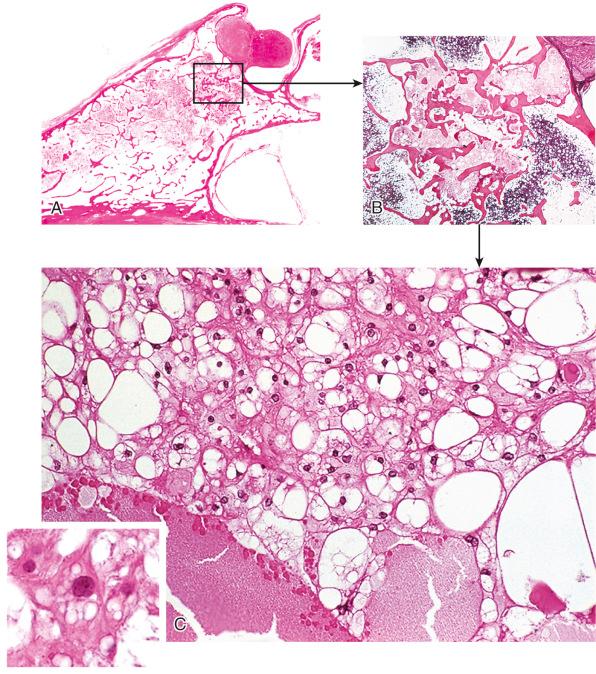
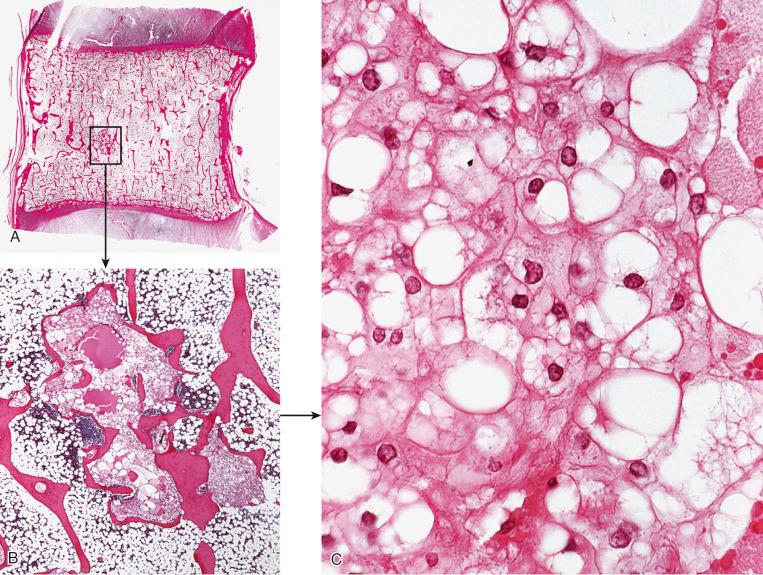
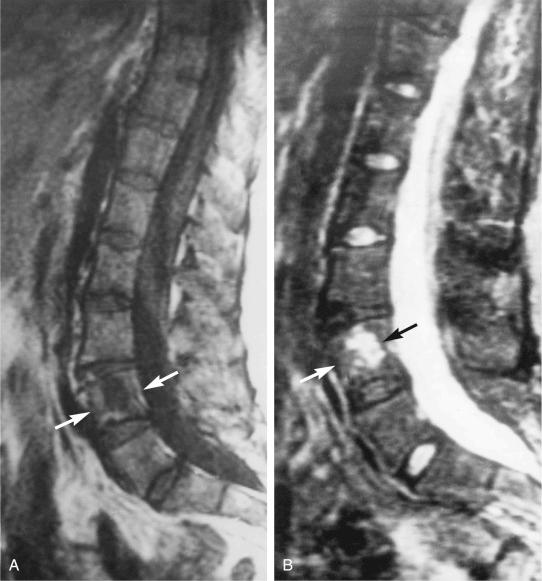
The published reports and our own experience indicate that symtomatic notochordal rests typically measure at least 10 mm and may be multifocal involving several vertebral bodies. Microscopically such lesions are composed of a uniform, sheetlike proliferation of notochordal cells, which permeate and fill the intratrabecular spaces ( Fig. 18-7 ). The trabecular bone is preserved but may show features of remodeling and sclorosis focally. Thickened trabecular bone may have central cores of hyaline cartilage with peripheral seams of partially calcified or ossified cartilage. The lesion has a nonagressive growth pattern with pushing borders and is sharply delineated from the adjacent tissue. The notochordal cells are closely packed with no intercellular stroma. Most cells have clear cytoplasm and resemble fat at low magnification. In contrast, to adipocytes in the nuclei of notochordal cells are frequently centrally located and are surrounded by the cytoplasm, which forms eosinophilic strands delineating vacuolar structures.
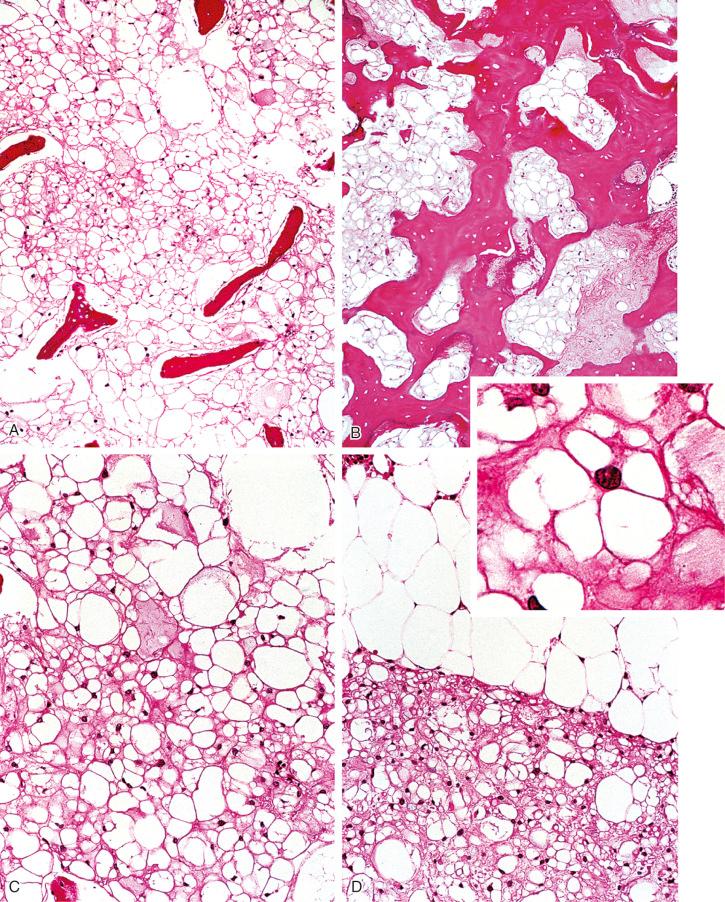
Immunohistochemically both small and giant notochord rests retain phenotypic features of normal notochord and stain positive for keratins AE1/AE3, CAM5.2, EMA, S-100 protein, and brachyury ( Fig. 18-8 ). They are negative for p53 protein, Ki67 (MIB-1), and high molecular weight keratin 34βE12 (keratin 903).
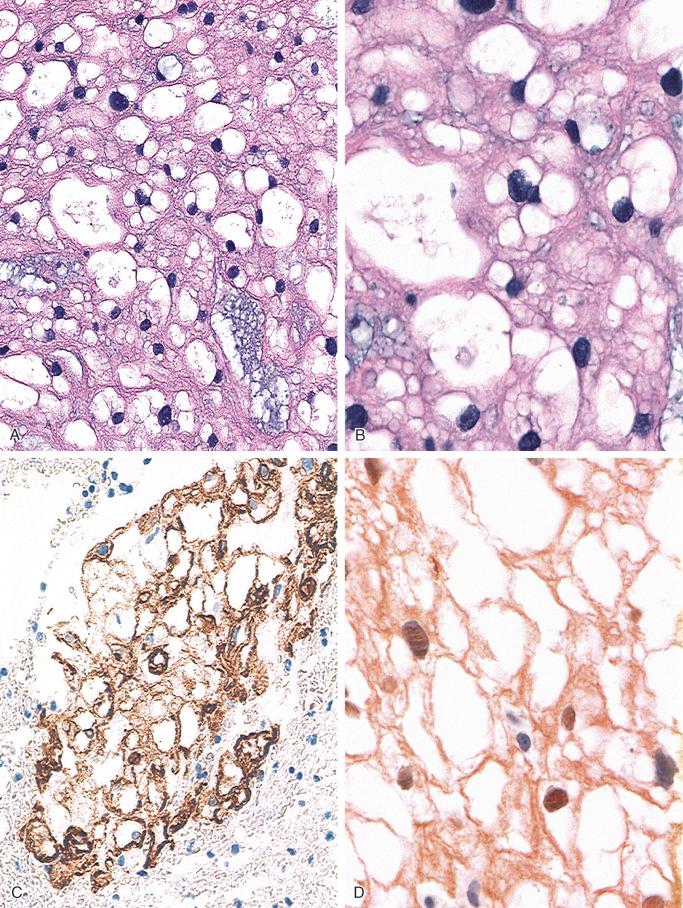
Notochordal rests may progress to a conventional chordoma. Chordomas associated with notochordal rests range from incidental microscopic findings to large destructive symptomatic lesions ( Figs 18-9 and 18-10 ).
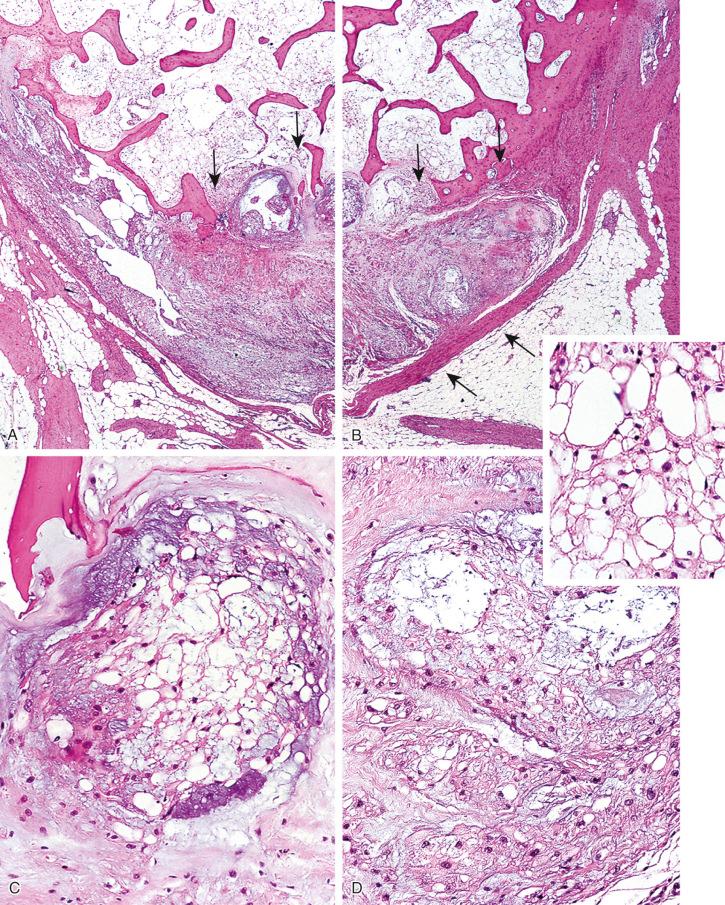
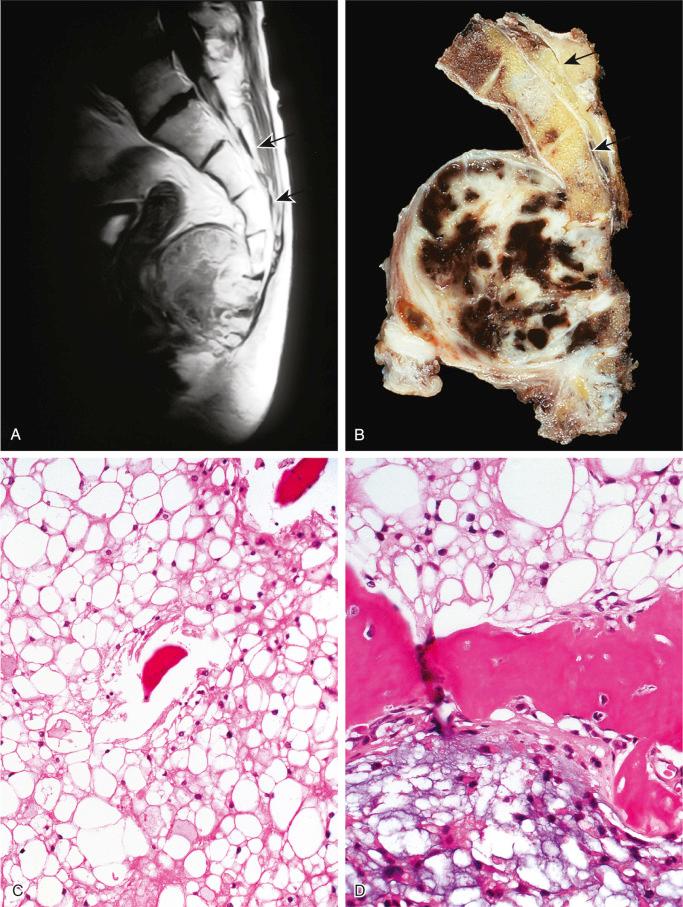
It is important that notochordal rests not be confused with chordoma . The correlation of microscopic features with radiologic images helps avoid this error. Extensive bone destruction with associated paravertebral soft tissue mass is the hallmark of chordoma. Microscopically notochordal rests lack the lobulation, mucinous stromal pools, and syncytial cell chords characteristic of chordoma. In addition, cellular atypia and heterogeneity is lacking in benign notochordal lesions. The bone both trabecular and cortical is typically destroyed in chordomas and is intact or focally thickened in benign notochordal lesions.
Chordoma is a slow-growing neoplasm that exhibits notochordal differentiation and most frequently arises in the sacrococcygeal and sphenooccipital regions. Some chordomas originate in the notochord rests, but it is unclear whether all tumors of this type arise from the persistent remnant of notochord tissue.
Chordoma is a relatively common tumor, accounting for 3% to 4% of primary malignant bone tumors in major series. The peak age incidence and the frequent sites of skeletal involvement are shown in Figure 18-11 . Chordoma appears to be the fourth most frequent primary malignant tumor of bone after osteosarcoma, chondrosarcoma, and Ewing's sarcoma. Approximately 8% of all primary malignant bone tumors were reported as chordomas to the National Cancer Institute's Surveillance, Epidemiology, and End Results (SEER) Program. The age-specific incidence and frequency distribution show gradual increases and peak during the fifth and sixth decades of life ( Fig. 18-12 ). It must be mentioned that a small number of chordomas occur during the first and second decades of life. In this age group, the involvement of the second cervical vertebra is typical. Very rare cases of congenital chordoma have been described. Some of the major series report a male sex predominance. However, SEER data show an almost equal male-to-female sex distribution. It appears that, similar to Ewing's sarcoma, chordomas are less frequent in black patients. In the SEER data, only 18 (2.1%) of 650 chordomas were reported in black patients.
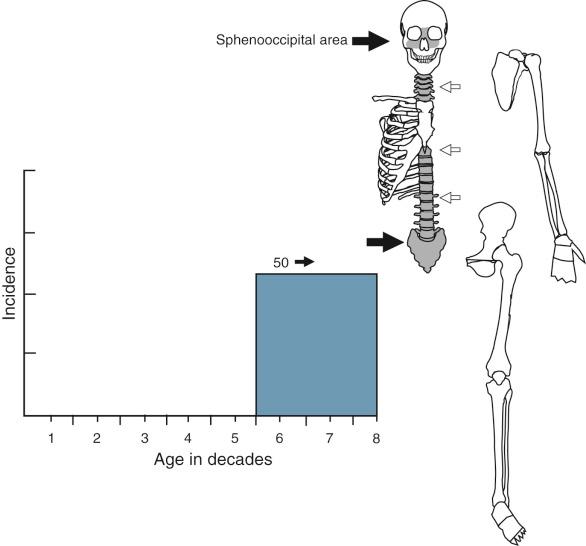
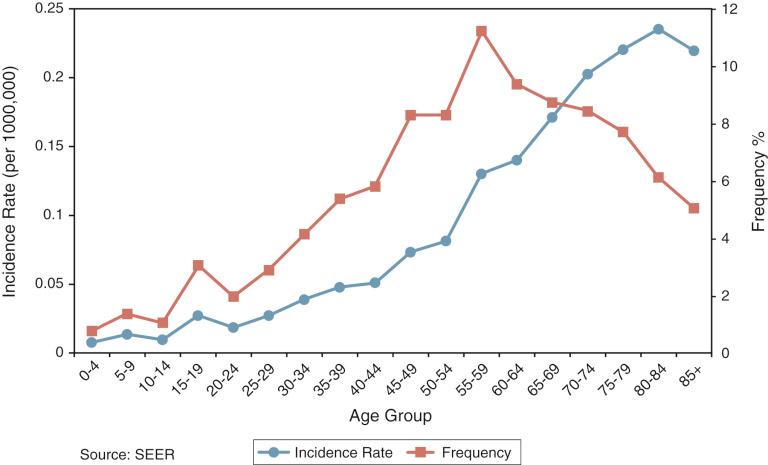
Chordoma almost exclusively involves the axial skeleton, which is in keeping with its notochordal origin. Nearly 90% of cases occur in the sacrococcygeal region and in the base of the skull. The remaining cases are reported predominantly in the cervical and lumbar spine. Involvement of the thoracic spine is rare. Extremely rare examples of multicentric chordoma involving several anatomic sites have been reported.
Pain is a common symptom in chordoma and can last for months to several years. Compression of the nerves in the sacrococcygeal region and obstruction of the rectum resulting in constipation are frequent presentations. Sphenooccipital chordomas produce symptoms related to compression or destruction of various adjacent structures, such as the optic nerves or pituitary gland. They also can present with symptoms characteristic of a tumor of the pontocerebellar region. Spinal chordomas frequently produce compression of the cord and nerves. Cervical chordoma frequently presents as a pharyngeal mass.
On plain radiographs, chordoma typically presents as a lytic lesion ( Fig. 18-13 ). Scattered, discrete opacities representing intralesional calcifications can be present. Sphenooccipital lesions destroy the clivus, the sella turcica, or both areas ( Figs 18-14 and 18-15 ). Sacrococcygeal lesions expand the bone contour and obliterate normal markings ( Fig. 18-16 ). Vertebral chordomas produce lytic lesions that may involve two or more adjacent vertebral bodies. Chordomas of the vertebral column and the sacrum originate in the vertebral bodies and produce masses that grow anteriorly to the dural sac ( Figs 18-17 to 18-19 ). Lesions of the coccygeal region, however, may grow both anteriorly and posteriorly to the sacrum ( Fig. 18-16 ). Chordoma may rarely present as a sclerotic lesion ( Fig. 18-13, B ). Computed tomography and magnetic resonance imaging are indispensable in evaluating both the extent of the lesion and the involvement of adjacent structures. Magnetic resonance imaging, in particular, can reveal the lobulated nature of the lesion, and T2-weighted images typically show signal enhancement ( Fig. 18-15 ).
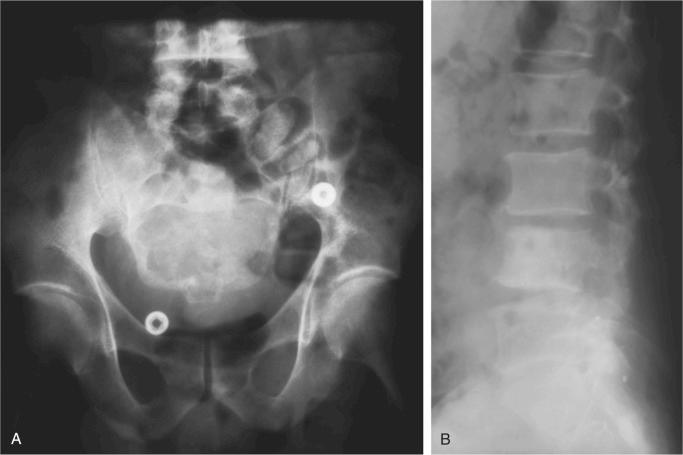
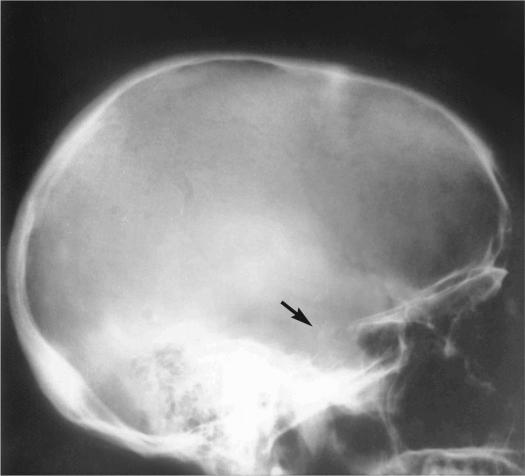
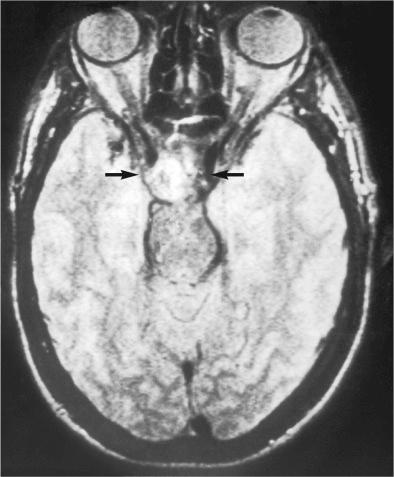
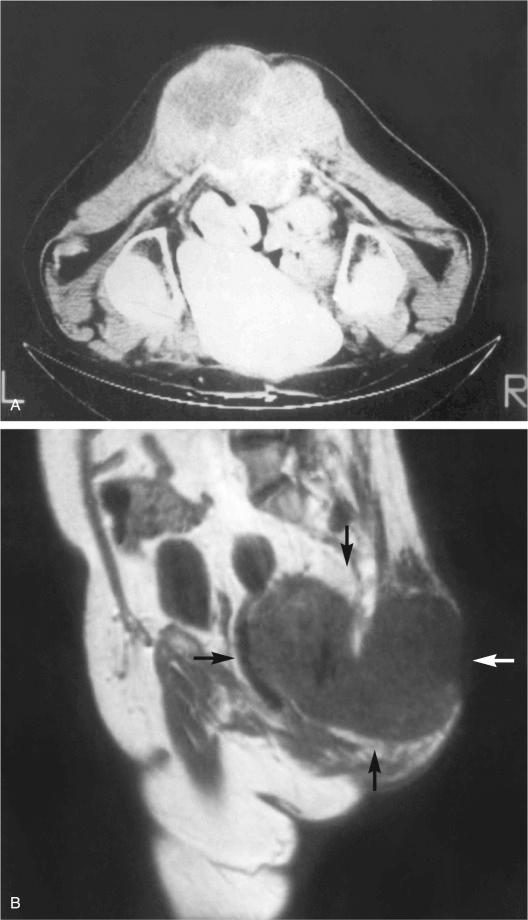
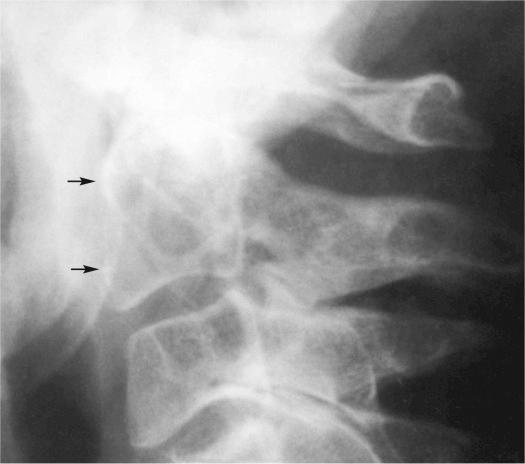
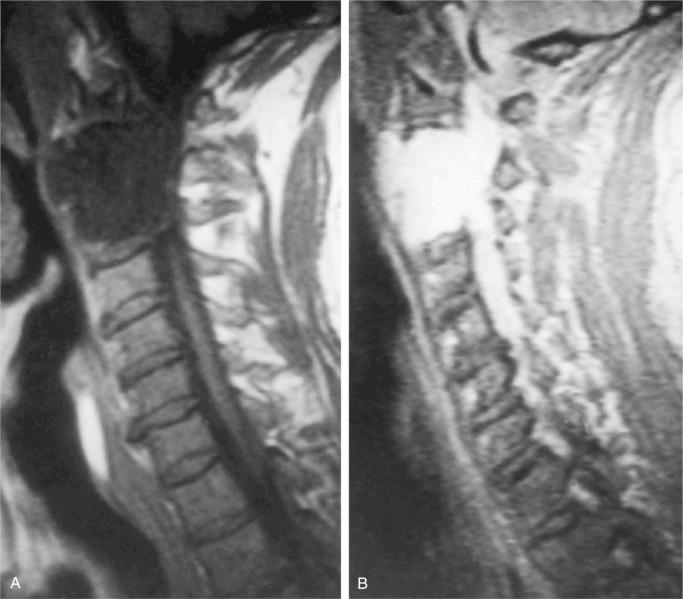
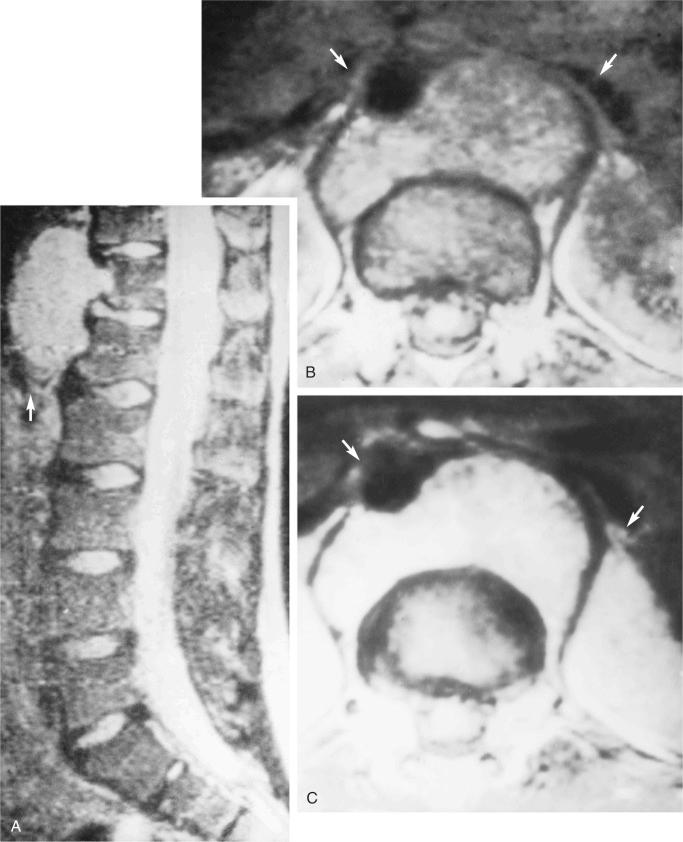
Chordomas are soft, gray-tan, multilobulated masses ( Fig. 18-20 to 18-22 ). They are frequently myxoid or gelatinous in appearance and can mimic chondrosarcoma or mucinous adenocarcinoma. The expanded bone contour is frequently delineated by a thin rim of periosteum. The intraosseous borders are typically indistinct. Despite good demarcation, the tumor usually extends beyond its grossly recognizable borders. The recurrent lesions are typically in the form of multiple nodules. Chordomas often involve the medullary canal, compressing the spinal cord and its nerves.
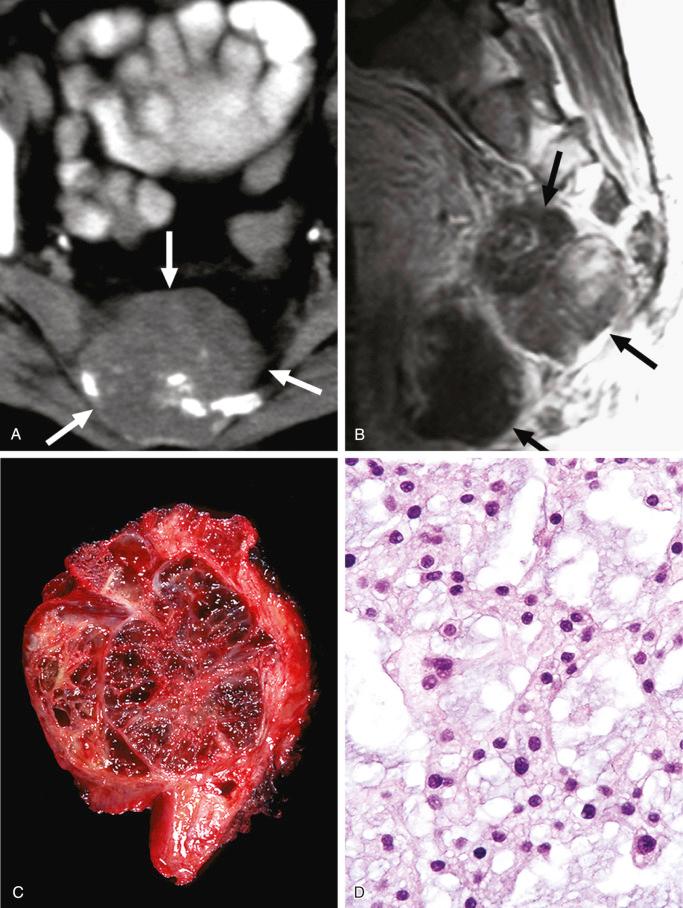
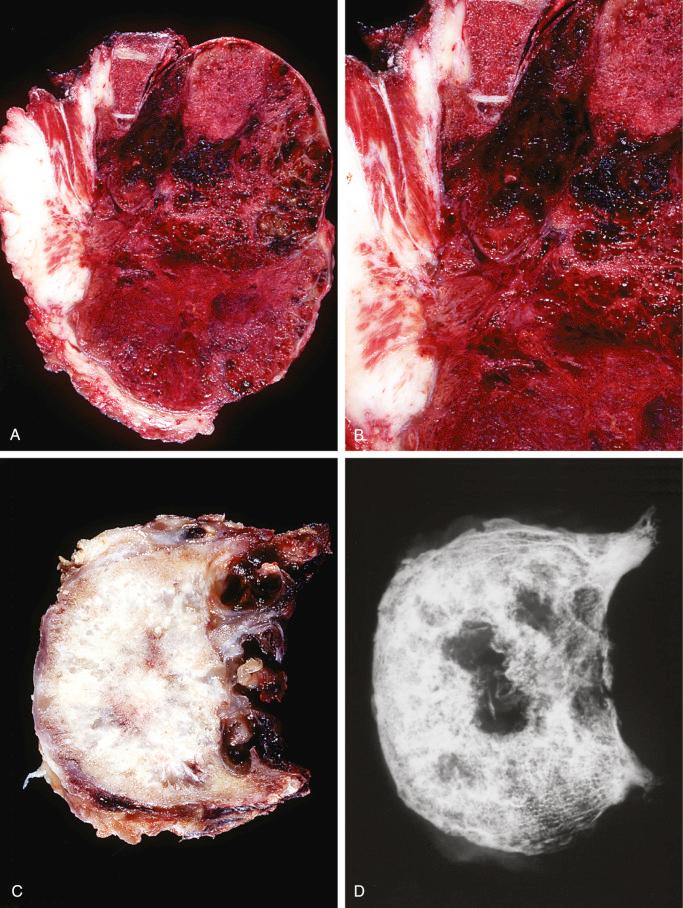
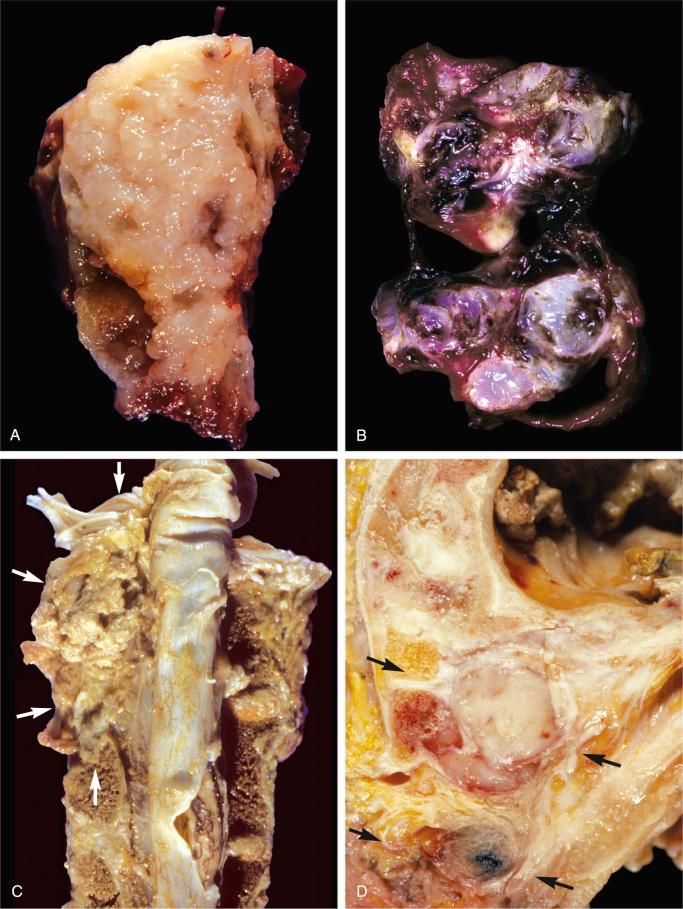
Chordomas are composed of cords or nests of solid areas of cells that have vacuolated cytoplasm embedded in a myxoid intercellular matrix ( Fig. 18-23 ). The nuclei are round or oval and have a prominent nucleolus. Mitoses are rare, and atypical mitotic figures usually are not present. The level of cellularity can vary considerably among cases and in different areas of the same tumor. Some tumors are highly cellular with minimal or no intercellular matrix. More often, there is a moderate amount of cellular tissue and clearly recognizable intercellular myxoid stroma. In a typical case, the tumor cells form an anastomosing pattern of cords with focal solid areas separated by a prominent intercellular matrix ( Fig. 18-24 ). In general, most chordomas exhibit clearly recognizable nuclear pleomorphism with occasional large atypical cells.
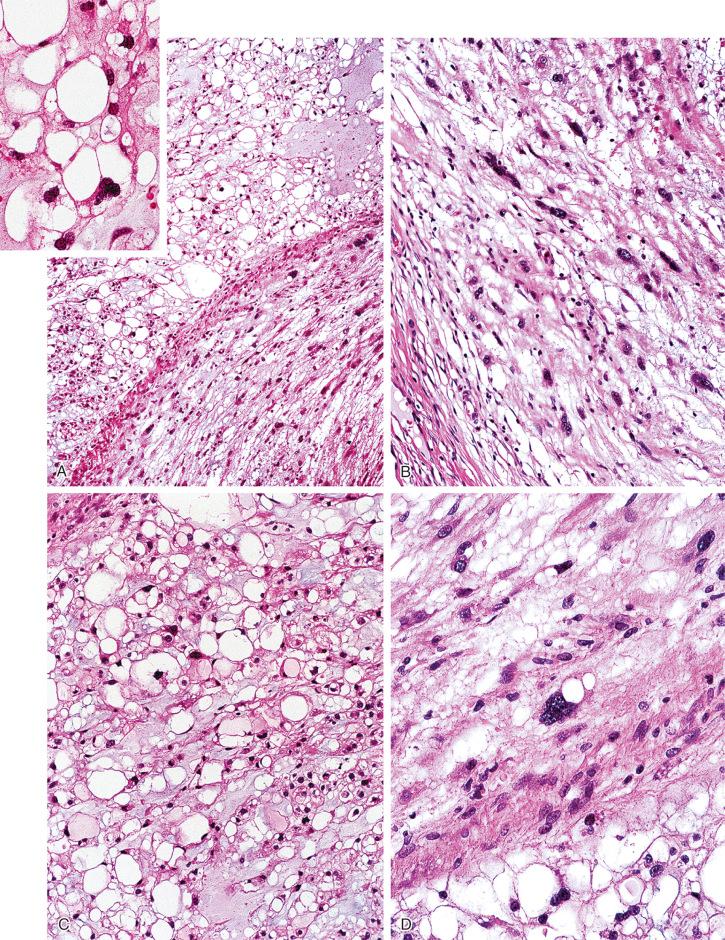
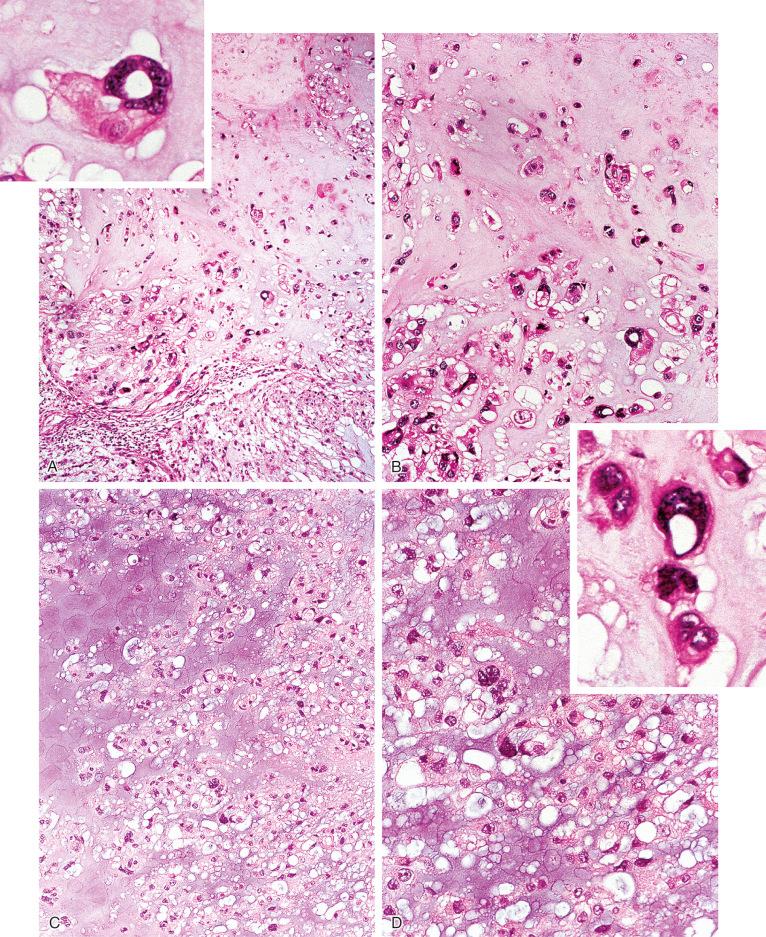
Vacuolization of the cytoplasm is almost invariably present ( Figs. 18-24 to 18-28 ). Frequently, it is in the form of large (single or several) vacuoles displacing the nucleus peripherally and causing the so-called signet-ring-like appearance of the tumor cells. It can also be in the form of smaller (multivesicular) structures. Occasionally, the vacuoles encircle the nucleus, which remains centered in the cytoplasm and produces the so-called physaliphorous appearance. The physaliphorous cell is a hallmark of chordoma ( Figs 18-29 and 18-30 ). It must be mentioned, however, that classic physaliphorous cells, as they are frequently illustrated in many pathology textbooks, are relatively sparse or may not be present at all in otherwise typical chordoma. The classic large physaliphorous cell has a centrally located nucleus surrounded by a narrow rim of cytoplasm that in turn, is encircled by a ring of more peripherally located cytoplasmic vacuoles. Extensive vacuolization of the cytoplasm may cause a clear-cell appearance of the tumor ( Fig. 18-28 ). Such lesions are descriptively referred to as lipoma-like chordomas and may be confused with benign or malignant lipomatous tumors. Some chordomas may have a sarcoma-like appearance caused by elongation of their nuclei and the presence of nuclear atypia ( Fig. 18-23 ). On the other hand, highly cellular lesions with minimal vacuolization and dense eosinophilic cytoplasm may mimic epithelial neoplasms.
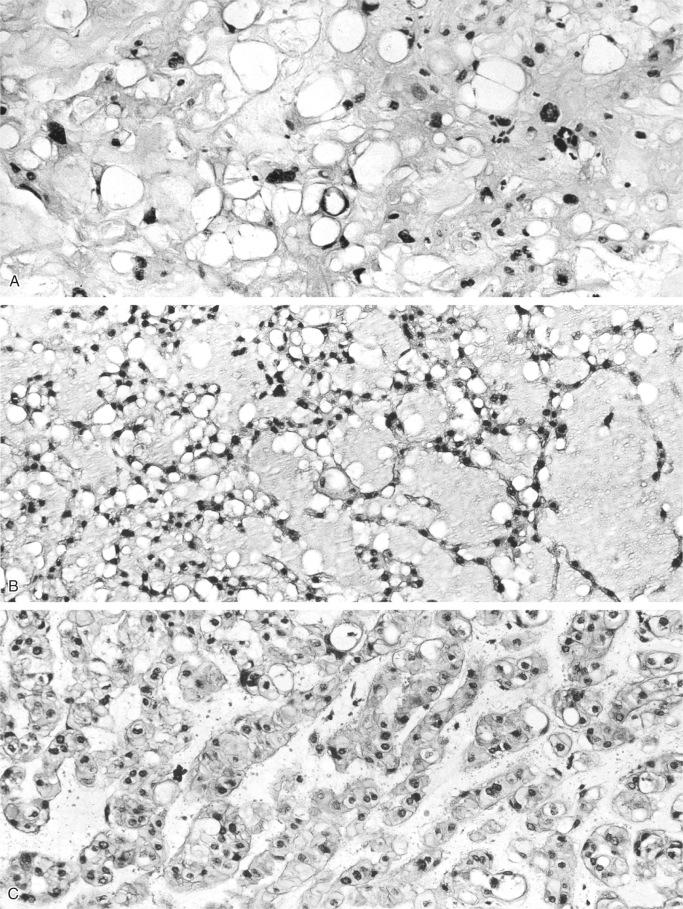
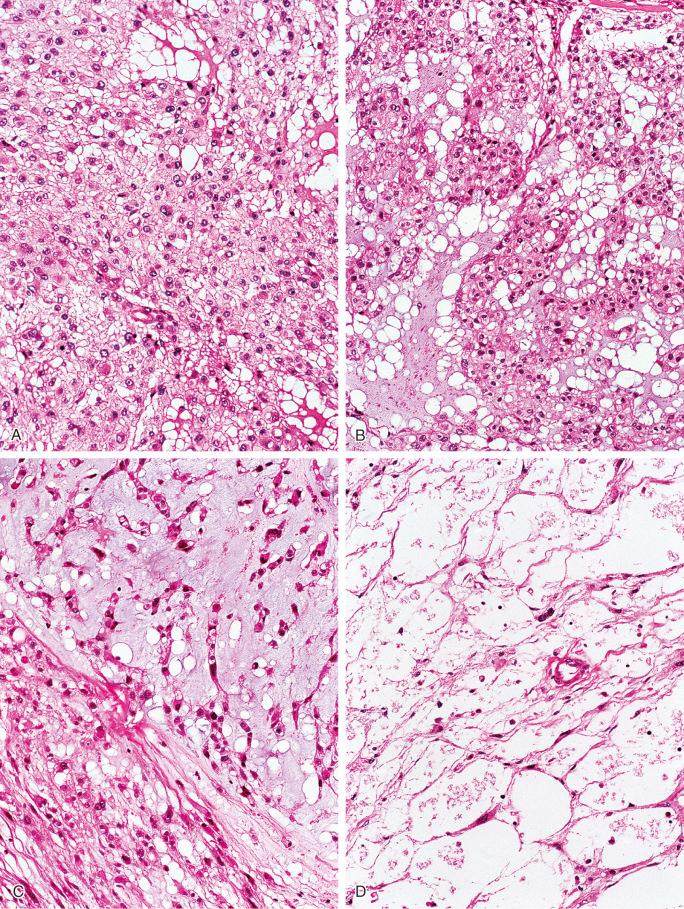
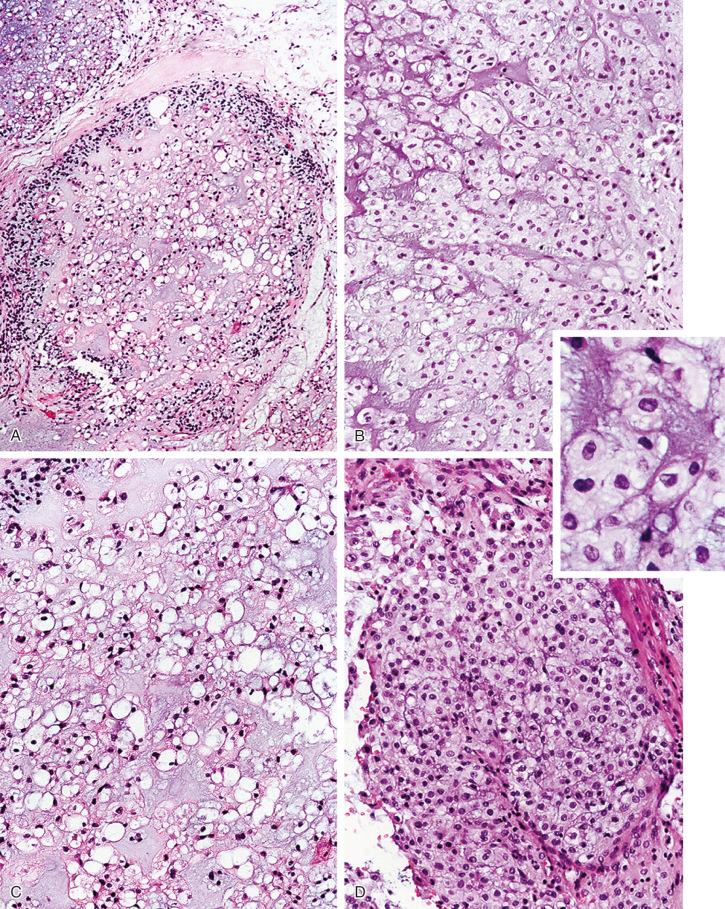

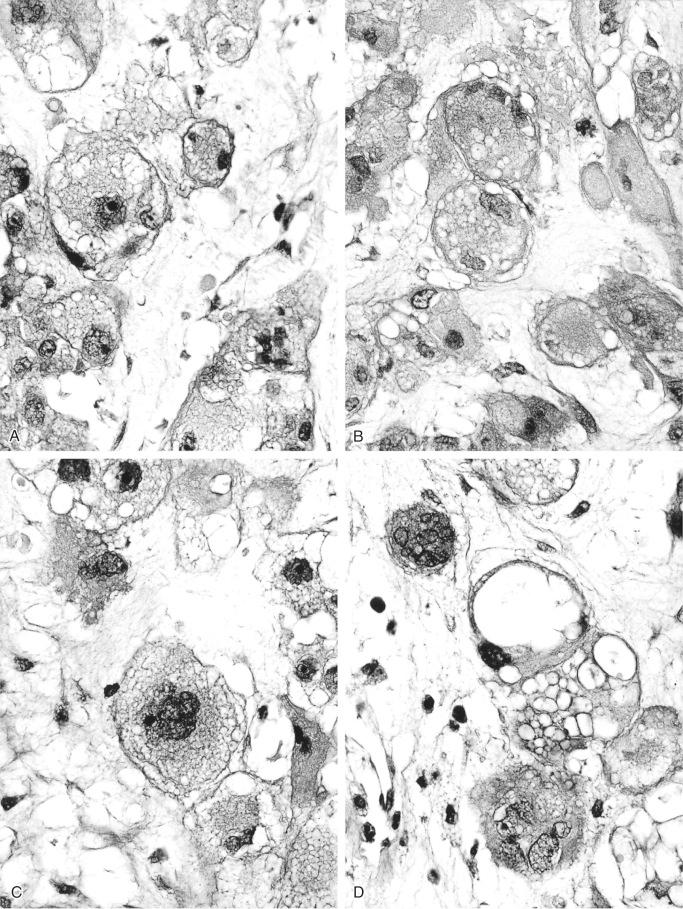
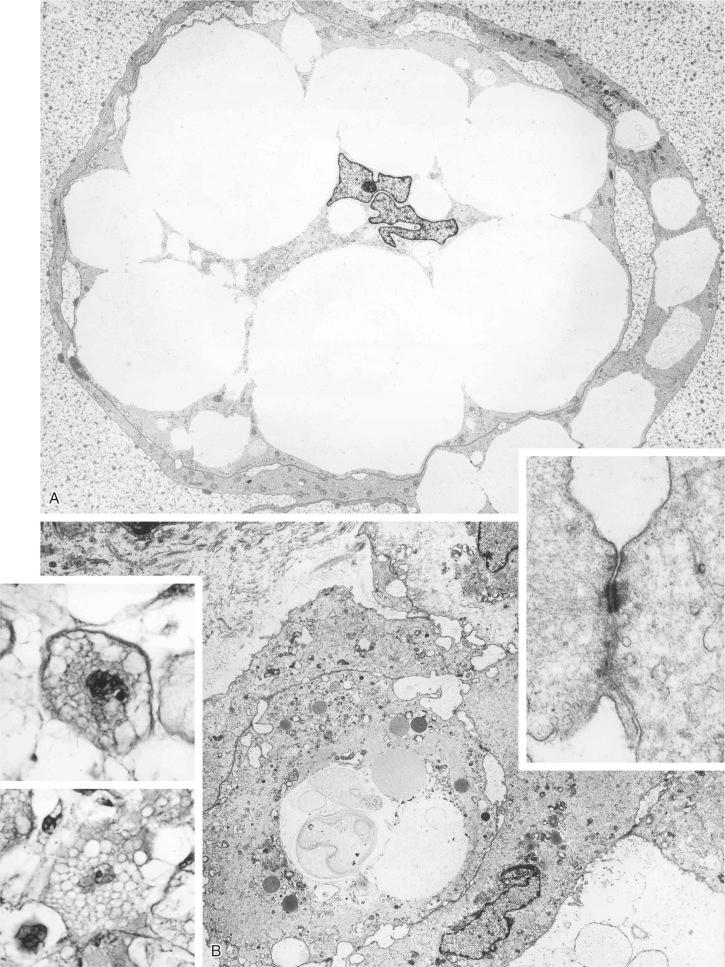
Chordoma may also exhibit cartilaginous differentiation. Areas of cartilage can range from small microscopic foci to large prominent areas. Therefore chordomas can be occasionally difficult to distinguish from chondrosarcoma. The term chondroid chordoma has been proposed to designate hybrid lesions that exhibit features of both lesions—chordoma and chondrosarcoma. The controversy over this entity and its potential for clinical significance are discussed separately.
Fine-needle aspirates from chordoma usually are cellular and contain abundant myxoid material admixed with clear, vacuolated neoplastic cells ( Fig. 18-31 ). The presence of abnormal multivacuolated cytoplasm with centrally placed, scalloped nucleus (that is, physaliphorous cells) is the hallmark of chordoma. Such classical cells are, however, rare; in the vast majority, the cells show dense eosinophilic cytoplasm or are lipoblast-like with single or several larger cytoplasmic vacuoles displacing the nucleus peripherally. Cytologic features combined with radiologic and clinical presentation allow correct cytologic diagnosis in most cases of chordoma. The immunohistochemical features such as coexpression of epithelial markers and S-100 protein can be also tested in cytologic preparations.
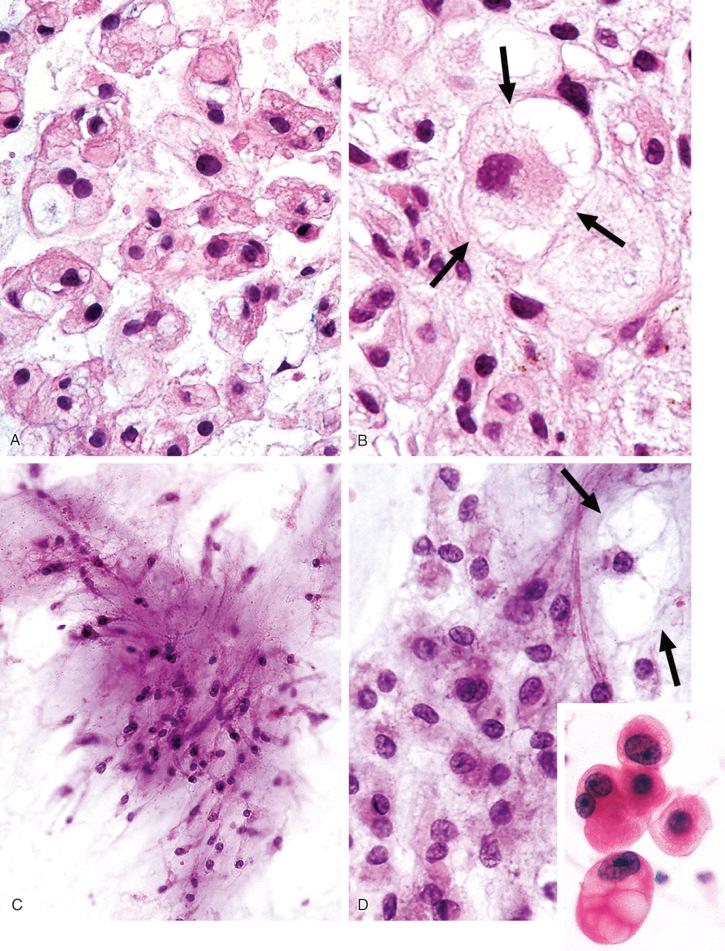
Become a Clinical Tree membership for Full access and enjoy Unlimited articles
If you are a member. Log in here